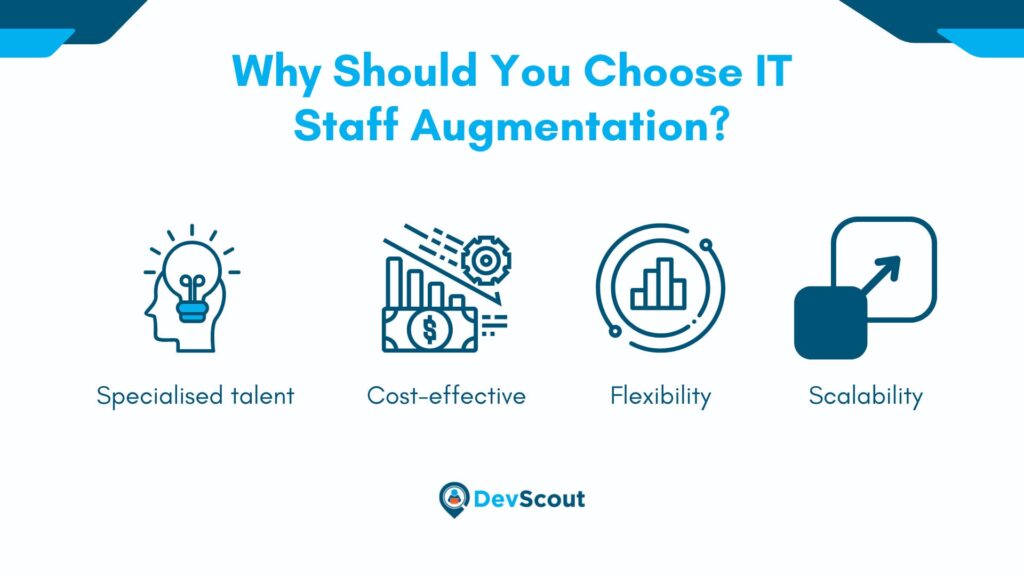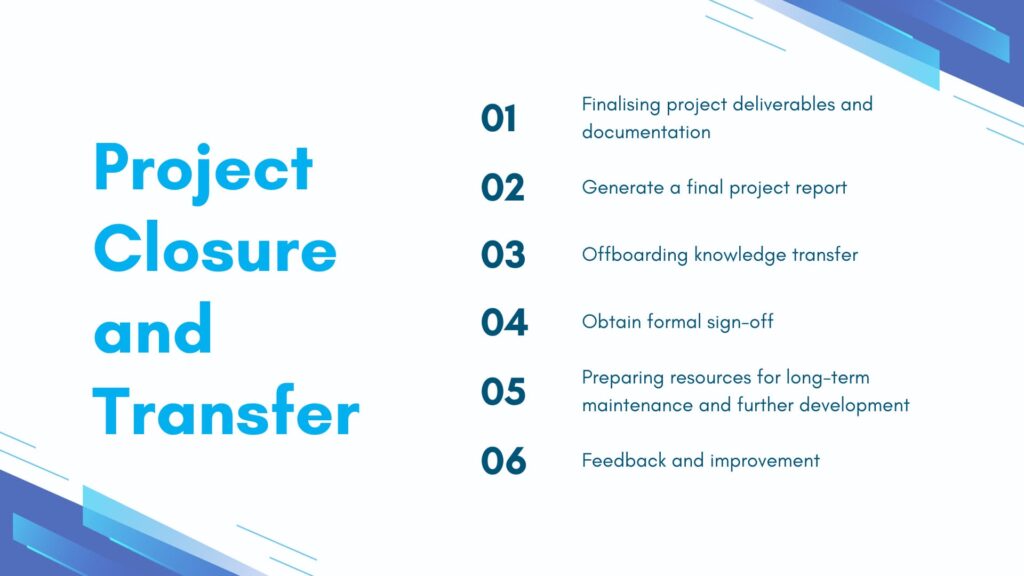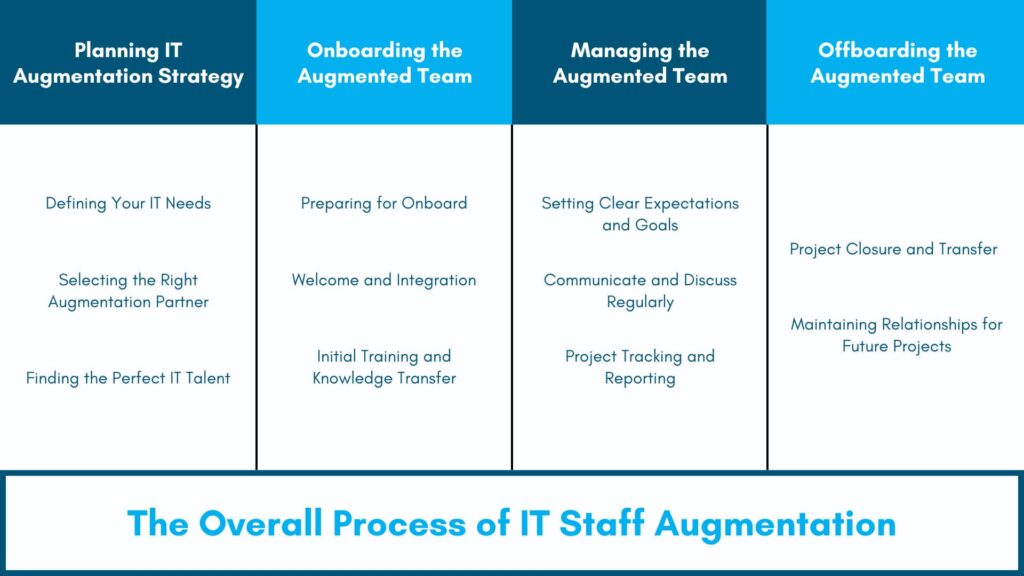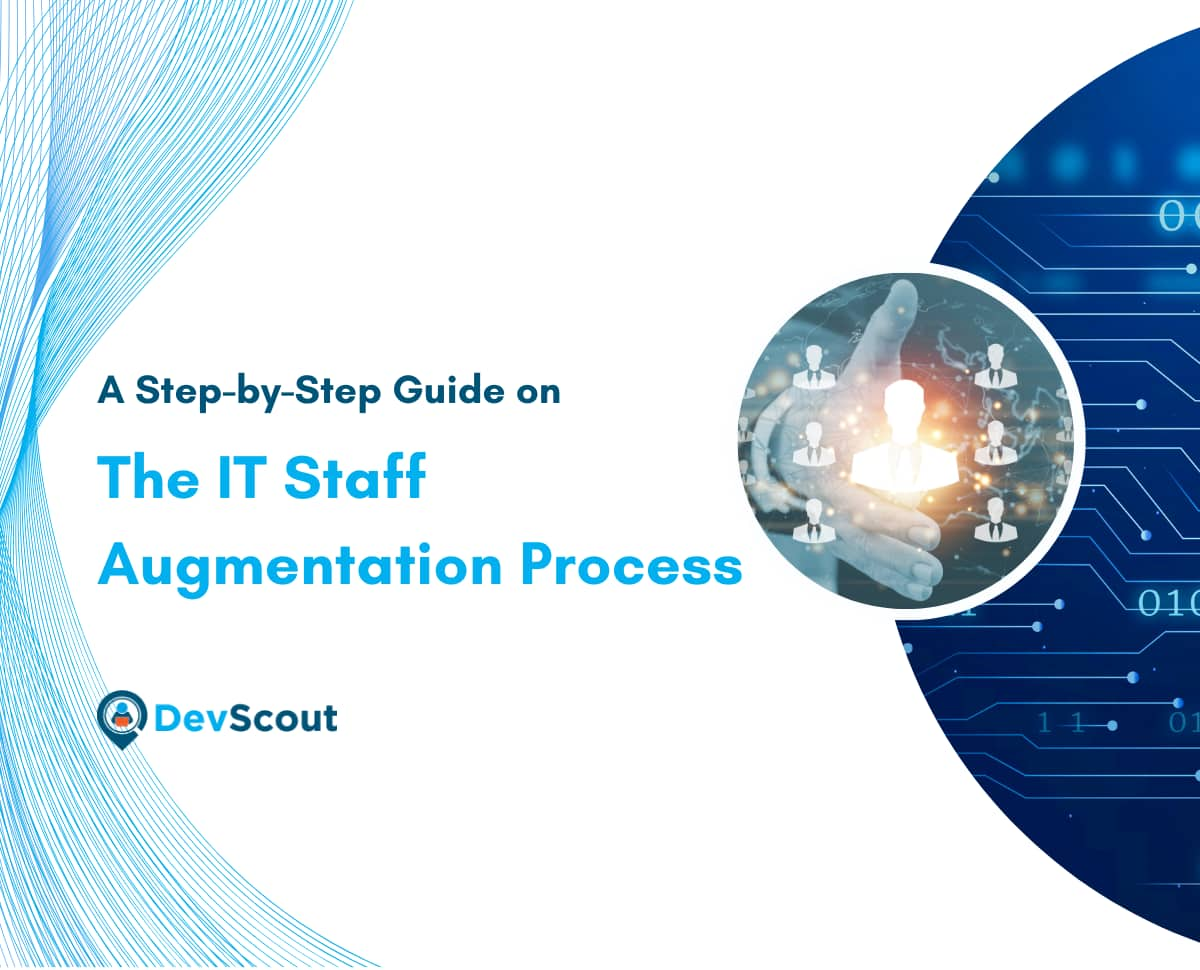The IT Staff Augmentation Process: A Step-by-Step Guide
According to BHSoft’s findings, IT Outsourcing is becoming increasingly popular due to the need for specialised tech skills in today’s rapidly evolving technological landscape. With its flexibility, IT staff augmentation stands out as a prominent outsourcing model for businesses needing to bridge the expertise gap fast. However, common challenges in outsourcing like slow onboarding, remote team management, and communication barriers can hinder its success. Therefore, a well-defined process is crucial for overcoming these obstacles and maximising benefits.
This article will explore the key steps in a successful IT staff augmentation process, providing a roadmap for organisations looking to leverage this powerful staffing strategy effectively.
1. Understanding IT Staff Augmentation
1.1. What is IT Staff Augmentation?
IT staff augmentation involves temporarily expanding your existing IT team by adding skilled professionals from an external provider. As a result, the client retains full control over the project scope, direction, and team management. It’s a temporary partnership, focused on supplementing existing resources with specialised expertise.
This differs significantly from project outsourcing, where the entire project is handed off, and managed services, where the provider manages ongoing IT infrastructure or functions. Instead, staff augmentation only provides skilled professionals who work directly under your supervision, integrated into your existing workflows and reporting structures.
Common roles augmented include software developers (front-end, back-end, full-stack), quality assurance testers, UX/UI designers, project managers, DevOps engineers, and data scientists.
Learn more about IT Staff Augmentation in this article.
1.2. Why Should You Choose IT Staff Augmentation?

There are several compelling reasons for making IT staff augmentation a winning strategy:
- Access to specialised talent: Taps into a broader pool of skills that may be hard or costly to find internally, with research from Zippia showing that 26% of small businesses outsource to get assistance from experts.
- Cost-effective: Reduces expenses associated with permanent hires (benefits, taxes, training).
- Flexibility: Enables scaling teams up or down as needed, avoiding long-term commitments.
- Enhanced scalability: Provides the right resources at the right time for agile operations.
Compare IT Staff Augmentation with other kinds of outsourcing models by reading this article: A Complete Guide to Evaluating Business Models for Outsourcing.
1.3. The Importance of an Established Process:
While the benefits of IT staff augmentation are clear, realising those benefits hinges on a well-defined and optimised process. A haphazard approach can lead to communication breakdowns, integration challenges, and ultimately, project failures. A robust process mitigates these risks by streamlining each stage, from initial needs assessment to final offboarding. It fosters seamless collaboration and communication, and ultimately maximises the return on investment.
A well-defined and optimised IT staff augmentation process is key to successful project outcomes and long-term partnerships, unlocking the true potential of this powerful staffing strategy. In the following sections, we are going to discuss the tips for each different stage of the augmentation process.
2. The First Stages: Planning Your IT Staff Augmentation Strategy
The foundation of a successful IT staff augmentation engagement lies in meticulous planning and strategic selection. Rushing this phase can lead to costly mistakes and ultimately jeopardise project success. Let’s examine the key steps involved:
2.1. Defining Your IT Needs:
Before engaging any augmentation partner, thoroughly analyse your current IT resources and identify skill gaps. This involves:
- Define project scope and requirements: Clearly define the project goals, timelines, deliverables, and specific technological requirements. What are the key tasks? What specific skills and experience are needed?
- Perform skill gap analysis: Identify the missing skills or expertise within your existing team (development skills, specialised testing, DevOps expertise…). Be precise in defining these requirements.
- Decide team composition: Based on your analysis, determine the ideal composition of your augmented team (the number of team members, their specific roles, team dynamics,…).
This meticulous needs assessment provides the bedrock upon which your entire augmentation strategy will be built.
2.2. Selecting the Right Augmentation Partner:
Choosing the right partner is crucial. It’s not just about finding a provider who can fill your needs, but one that fits your needs. Consider these criteria:
- Has a proven track record: Seek providers with extensive experience in IT staff augmentation, demonstrated by a portfolio of successful projects and positive client testimonials.
- Appropriate technical expertise: Assess the provider’s expertise in the specific technologies and skill sets required for your project.
- Clear collaboration: Choose a provider that offers transparent communication, regular updates, and a responsive and collaborative approach.
- Aligned values: Ensure the provider’s company culture aligns with yours. This promotes smoother integration of the augmented team into your workflows.
- Compliance and security: Verify the provider’s adherence to relevant industry standards and regulations, particularly concerning data security and intellectual property.
2.3. Finding the Perfect IT Talent:
Once you’ve chosen a partner, the collaborative candidate selection process begins. This should involve:
- Detailed candidate profiles from the provider, highlighting their skills, experience, and relevant certifications.
- Technical assessments, such as coding challenges, interviews, and portfolio reviews ensure candidates possess the required skills and are culturally fit.
- Background checks: Conduct thorough background checks to ensure candidate legitimacy and protect your company’s interests.
Therefore, to increase your chances of finding the perfect candidates, partnering with a provider that has access to a large and diverse talent pool can be a game changer.
This rigorous process ensures a high-performing, integrated team and forms the fundamentals of successful IT staff augmentation.
Learn more about what to keep in mind in this stage through this guide.
3. The Second Stage: Onboarding Your IT Augmentation Team
A seamless onboarding experience is critical for maximising the productivity and effectiveness of your augmented IT team. Let’s explore the key elements:
3.1. Preparing for Onboarding Success:
Effective onboarding requires proactive preparation. First, ensure resources are ready, including credentials (VPN, tools, repositories) and necessary hardware/software. Next, you should establish clear communication channels (e.g., Slack, Teams) and guidelines, addressing time zone differences. Furthermore, you can create a dedicated physical or virtual workspace for the team. This might involve assigning seats in the office or creating a dedicated channel within your communication platform to create a sense of belonging and facilitate collaboration. Consider establishing communication protocols for different situations (daily stand-ups, weekly progress reports, urgent issues) as well. Finally, gather and provide easy access to all relevant project documentation and resources.
3.2. Welcome and Integration:
The first few days are crucial for setting the tone for the entire engagement. You need to make sure that the augmented team members understand their roles and responsibilities, and truly get on with the new environment. This can be achieved by arranging a formal introduction, holding a kickoff meeting and announcing all of the necessary procedures and regulations. Additionally, you can encourage team-building activities, even informal ones, to build rapport. This helps the augmented team members quickly become integrated into the existing team dynamics.
3.3. Initial Training and Knowledge Transfer:
The key to making augmented staff quickly familiarise themselves with the task is to provide them with important information. Here are some of the things you can do:
- Transfer knowledge and backgrounds of the project: Simply dropping them into the project can cause understanding gaps, not just about expertise but the context surrounding the task. Instead, give them structured knowledge transfer sessions. This might involve pairing them with experienced team members or providing comprehensive documentation about the project’s specifics (technologies, methodologies, or any specialised tools/processes involved).
- Company culture orientation: Brief the team on your company culture, values, and internal processes to have better chemistry with your company.
- Ongoing mentorship/support: Assign mentors or provide ongoing support to address questions and challenges that arise during the initial onboarding period.
Successful onboarding goes beyond mere paperwork and introductions; it’s about integrating augmented team members into your company culture and creating a sense of belonging, enabling them to contribute effectively from the start.
4. The Third Stage: Managing Your Augmented IT Team Effectively

4.1. Setting Clear Expectations and Goals
While initial onboarding meetings cover project scope and individual roles, it’s essential to reinforce these key elements throughout the project lifecycle. Regularly reaffirming the project’s overarching goals and how each team member contributes to the bigger picture keeps everyone focused and motivated. Clarify individual responsibilities and reporting structures, addressing any ambiguities that may arise as the project progresses. This ensures consistent alignment, promotes accountability and allows for adjustments as the project evolves.
Besides that, establishing clear, measurable Key Performance Indicators (KPIs) aligning with project goals is a must.
4.2. Communicate and Discuss Regularly
Clear and consistent communication is the cornerstone of a successful augmented team. In addition to setting up channels and some communication rules as mentioned before, you should also implement the following:
- Schedule regular meetings (daily stand-ups, weekly progress reviews) to discuss progress, address challenges, and maintain alignment. For remote or hybrid teams, you can utilise video conferencing tools to keep in touch. The frequency should be tailored to the project’s complexity and the team’s dynamics.
- Transparent communication with the provider: Keeping the augmentation provider informed of any challenges or concerns. Their involvement in resolving issues and maintaining team performance is crucial.
4.3. Project Tracking and Reporting
Consistent monitoring and regular feedback are essential for keeping the project on track and improving work efficiency. Here are the things you can do:
- Set regular feedback loops: Implement a system for regular feedback, both formal and informal. Provide constructive criticism, acknowledge achievements, and address any performance concerns promptly and professionally.
- Generate performance reports, highlighting key achievements, challenges, and any necessary adjustments to the project plan. Share these reports transparently with stakeholders to maintain alignment and manage expectations.
- Utilise project management tools and dashboards to monitor progress against milestones, track individual contributions, and identify potential roadblocks early.
- Then, proceed to formal performance reviews: Conduct regular performance reviews (e.g., quarterly or bi-annually) to evaluate individual performance against pre-defined KPIs and goals. These reviews assess contributions, give constructive feedback, recognise accomplishments, and identify areas for professional development. Address any performance issues promptly and professionally, and cooperate with the augmented team member and the provider to create a performance improvement plan and monitor progress.
By implementing these strategies, you can ensure your augmented IT team operates efficiently, collaborates effectively, and consistently delivers high-quality results. Proactive management fosters a positive and productive working environment, leading to better project outcomes and stronger long-term partnerships.
5. The Fourth Stage: Offboarding Your IT Staff Augmentation Team
While onboarding is crucial for a successful start, a well-managed offboarding process is equally vital for a smooth conclusion and sets the stage for future collaborations. This involves careful knowledge transfer, formal project closure, and maintaining positive relationships.
5.1. Project Closure and Transfer

This ensures a seamless handover and valuable insights for future projects.
- Finalising project deliverables and documentation: Before the augmented team departs, ensure all project deliverables are finalised and accepted. Thoroughly document the completed work, including code repositories, design specifications, test results, and any other relevant information. This final review ensures that everything is in order and readily accessible to your internal team.
- Offboarding knowledge transfer: While initial knowledge sharing occurs during onboarding, the offboarding phase provides a dedicated opportunity for a more comprehensive knowledge transfer. Schedule dedicated sessions where augmented team members can share their in-depth expertise like code walkthroughs, insights, and best practices with your internal team.
- Preparing resources for long-term maintenance and further development: Consider creating detailed runbooks, standard operating procedures (SOPs) covering routine operations and troubleshooting, and training materials based on the knowledge gained during the project.
- Generate a final project report, summarising key achievements, challenges encountered, and lessons learned.
- Obtain formal sign-off from relevant stakeholders to confirm project completion and acceptance of deliverables. This formal closure provides a clear record of the project’s outcome and serves as a valuable reference for future engagements.
- Feedback and improvement: Collect feedback from all stakeholders (client, augmented team, provider), including exit interviews. Use this feedback to identify areas for improvement, refine the staff augmentation process, document lessons learned, and maintain a repository of best practices for future projects.
5.2. Maintaining Relationships for Future Projects
Ending a project doesn’t mean ending the relationship. Cultivating positive relationships offers numerous benefits:
- Streamlined future engagements: Maintaining a positive relationship with the provider simplifies the process and minimizes the time and effort of engaging additional staff for future projects. You’ve already established trust and a proven working relationship.
- Continuous improvement and optimisation by keeping in touch with both the provider and augmented team members.
A well-executed offboarding process is not just the end of an engagement, but a crucial step in building a strong foundation for future collaborations. It ensures a smooth transition, protects your investment, and facilitates efficient and cost-effective IT staffing for future needs.
Conclusion
Here’s our recommended process for IT Staff Augmentation:

A well-defined IT staff augmentation process is crucial for success, but navigating its complexities can be challenging. That’s where DevScout comes in. We partner with businesses to provide comprehensive workforce solutions, including expert IT staff augmentation, designed to streamline the entire process. From meticulous planning to seamless offboarding, we handle the details so you can focus on your core business objectives. Whether you need IT staff augmentation, dedicated team services, or software development support, we offer tailored solutions to meet your unique needs. Explore our platform today and discover how DevScout can be your strategic partner for success. Contact us for our expert consultation!

